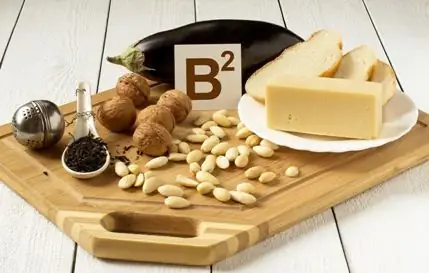- Author Rachel Wainwright [email protected].
- Public 2023-12-15 07:39.
- Last modified 2025-11-02 20:14.
Vitamin P
Vitamin P (often called rutin) is a group of biologically active substances that are bioflavonoids. In total, it includes about 150 vitamins with rutin properties: these include coumarins, catechins, anthocyanins, hesperidin, quercetin and many others.

Vitamin P was isolated from lemon peel by the American biochemist Albert Szent-Gyorgyi in 1936 as a substance that increases the strength of the vascular wall and capillaries.
Vitamin P supplementation
The pharmacological action of the vitamin consists in active participation, together with vitamin C, in the redox reactions of the body (due to the close interaction with ascorbic acid, the group of bioflavonoids is also called vitamin C2). Vitamins of group P protect adrenaline and vitamin C from oxidation, partially relieve the degree of vitamin deficiency of ascorbic acid, reduce fragility and permeability of capillary vessels, have a pronounced antiallergic, anti-edema, anti-inflammatory and mild antispasmodic effect.
Vitamin P supports the structure, function, elasticity and permeability of blood vessels, preventing them from hardening and helping to maintain a stable blood pressure.
It is believed that vitamin P, when taken regularly for at least 4 weeks at a dosage of no more than 60 mg / day, reduces the level of intraocular pressure, which makes the element an indispensable means of preventing glaucoma. In addition, the bioflavonoid is able to gently stimulate the active activity of the adrenal cortex, thereby increasing the production of glucocorticoids.
Depending on their purpose, P group vitamins have hypoazotemic, antitumor, anti-inflammatory, anti-ulcer, choleretic, radioprotective and some other effects on the body.
Sources of Vitamin P
Despite the fact that the exact human need for vitamin P has not been established, the approximate figures are still named - they are half the norm of vitamin C or 35-50 mg of bioflavonoids per day. The therapeutic dose of the vitamin is 100-200 mg / day.
A vitamin P deficiency is often combined with a lack of vitamin C in the body, since both have the same sources of intake (vegetables and fruits).
Vitamin P content in foods:
- Chokeberry (4000 mg);
- Cherries (1200-2500 mg);
- Black currant (900-1500 mg);
- Dry rose hips (650-680 mg);
- Lemons, oranges (500 mg);
- Red bell peppers, sorrel (500 mg);
- Lingonberry (350-600 mg);
- Cranberry (250-330 mg);
- Dark cherry (230-900 mg);
- Gooseberry (230-550 mg);
- Pomegranates (200-700 mg);
- Quince (200-820 mg);
- Strawberries (150-210 mg);
- Dill (170 mg);
- Parsley leaves (157 mg);
- Plum (110-300 mg);
- Pear (100-250 mg);
- Peaches (50-350 mg);
- Carrots (50-100 mg);
- Potatoes (20-35 mg);
- Apples (10-60 mg)
Since vitamin P is not synthesized by the body, and its excess does not accumulate in the tissues, the above foods must be included in the daily diet of a person.
Despite the fact that vitamin P in plant products is contained in sufficient quantities, heat and chemical treatment, oxygen, sunlight destroy bioflavonoids. A similar effect is experienced by the tissues of a person who smokes, who, by their addiction, reduces the amount of vitamin P in the body.

Indications for the use of vitamin P
For medicinal purposes, vitamin P is used for diseases such as:
- Myocarditis, endocarditis, rheumatism;
- Hemorrhagic diathesis, radiation sickness, retinal hemorrhage;
- Chronic glomerulonephritis;
- Arachnoiditis;
- Hypertension, ischemic heart disease;
- Allergy.
Lack and excess of vitamin P
Depletion of the body with vitamin P is accompanied by a feeling of malaise, general weakness, rapid fatigue, pain in the limbs, periodontal disease, punctate hemorrhages under the skin, hair loss, acne.
Excess vitamin P poses no threat as it is easily excreted from the body naturally.
Found a mistake in the text? Select it and press Ctrl + Enter.






